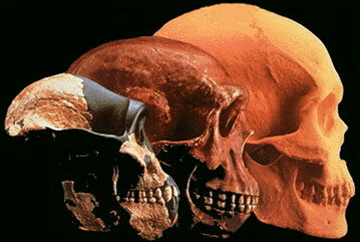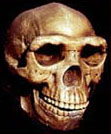Overview of Human Evolution
- Page 6 -
Finding the “Missing Link”
 |
The main lines of Darwin's theory can be seen at a glance in the image of the three skulls to the left. The emergence of our distinctive species characteristics would, he understood, have proceeded in gradual stages over an extended period of time. The earliest common ancestor of humans and hominids would also be an ancestor of the African apes. It followed, then, that if we were to find fossil specimens of our ancestors, they would share characteristics with ape species. And the older the human/hominid specimen (and therefore the closer to the common ancestor), the more ape-like in appearance our ancestor would be.
|
|
This line of thinking led to a search for the expected intermediate forms between apes and humans—and was the basis for the famous concept of a "missing link" popular in nineteenth-century journalism. To prove Darwin’s theory of human descent, it was argued, someone had to find fossil evidence of human-like creatures older than ourselves who still had ape-like characteristics.
Influenced by Darwin's work, Dutch naturalist Eugene Dubois set out in 1891 to confirm the theory and to find the "missing link." Dubois differed from Darwin, however, in assuming that humans had evolved in tropical Asia rather than in Africa. Accordingly, Dubois searched in what is now Indonesia, on the island of Java. Near the Solo River, he found a fossil skull cap and a thigh bone that seemed to him to confirm Darwin’s theory; they bones were intermediate forms between apes and modern humans. He named his find "Pithicanthropus erectus" or "erect ape-man." The public named it "Java Man." Here was proof of Darwin’s theory. As more information accumulated, this species was re-named "Homo erectus"--"erect or upright man." The earliest specimens of this species have since been found in Africa.
|

A composite Homo erectus skull is shown to the left. While no longer believed to be the first human species to migrate out of Africa, Homo erectus was the first human species to adapt to a wide variety of environments in Europe and Asia.
Arguably, the discovery of a single ancestral species “intermediate” between modern humans and apes would seem to constitute adequate proof of Darwin’s hypothesis about human origins. But for political and religious reasons, objections to Darwin’s theory continue to be made, not from within the scientific community, but from outside it.
Since Dubois’ find in the late nineteenth century, our knowledge of ancestral species and our understanding of the story of our origins have expanded exponentially. Every year adds significant discoveries to our knowledge of our past. There was, as it turned out, not one “intermediate” species between ourselves and the common ancestor, but many. More than twenty hominid species (depending on how the specimens are classified) have been unearthed by scientists so far, with new discoveries added almost every year. So instead of a simple, straight-line descent from the “common ancestor,” our family “tree” resembles a tangled bush or a wind-blasted pine with its lower limbs broken off. And though we know that our ancestors rubbed shoulders with a variety of related hominid species in earlier times, we modern Homo sapiens sapiens are the sole surviving member of our genus and, indeed, of the whole hominid family.
In place of Darwin’s informed guesses about our origins, we now have an abundance—perhaps, in some ways, even a super-abundance--of evidence about our origins. Currently, we have an outline of the story of human descent stretching back 7 million years, to the late Miocene. But because the evidence about human origins is more complicated and full of surprises than anyone guessed, each year has added to the number of questions as well. While each new discovery fills a gap in our knowledge, it also raises new issues; every gain in knowledge requires new perspectives on critical details of our journey. This is a story, then, that we currently possess in rough outline, in terms of its “chapter headings,” so to speak, while we would like to have every word and punctuation mark. We now know a great deal about the “descent of man,” but we want to know more.


